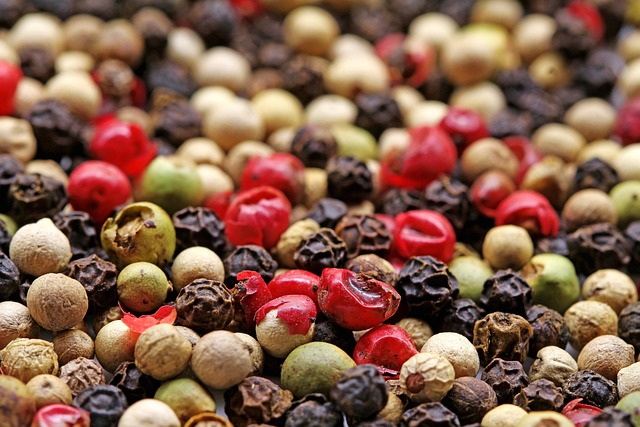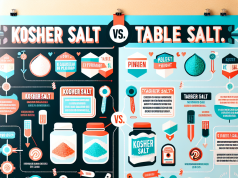Contents
Unleashing the Flavors: How to Properly Cook with White Pepper
White pepper is a versatile and aromatic spice that can add a unique flavor to your dishes. Its subtle heat and pungency make it a popular choice in many cuisines around the world. In this article, we will explore the proper techniques and methods to cook with white pepper, allowing you to unlock its full potential in your culinary creations.
Why Choose White Pepper?
White pepper comes from the same plant as black pepper but undergoes a different processing method. The outer layer of the peppercorn is removed, resulting in a milder and less spicy flavor compared to its black counterpart. This makes it an excellent choice for dishes where you want to add a subtle heat without overwhelming other flavors.
Proper Usage in Cooking
When using white pepper in your recipes, it is important to understand its potency. Unlike black pepper, white pepper’s flavor intensifies when heated, so a little goes a long way. It is best to start with small quantities and gradually adjust to taste.
White pepper pairs well with a variety of ingredients, including seafood, poultry, vegetables, and creamy sauces. It adds depth and complexity to soups, stews, stir-fries, and marinades. Additionally, it is a key ingredient in many traditional Asian cuisines, such as Chinese and Thai dishes.
Storage and Quality
To preserve the flavor and quality of white pepper, store it in an airtight container in a cool, dry place away from sunlight. This will help retain its aroma and prevent moisture from affecting its taste. It is recommended to replace your white pepper every 6 to 12 months to ensure optimal freshness.
Conclusion
White pepper is an essential spice in many kitchens, known for its delicate heat and distinctive flavor. By understanding how to properly cook with white pepper, you can enhance the taste of your dishes and experiment with new culinary creations. Incorporate this versatile spice into your cooking repertoire and embrace the possibilities it brings.
Unleashing the Flavors: How to Properly Cook with White Pepper
What is White Pepper?
White pepper, scientifically known as Piper nigrum, is a spice commonly used in various cuisines worldwide. It originates from the same pepper plant as black pepper, but the difference lies in the processing method. White pepper is derived from fully ripe berries, soaked in water, and the outer skin is removed before drying. This process results in a milder and subtler flavor compared to its black counterpart.
The Unique Taste of White Pepper
White pepper possesses a unique and delicate flavor profile. It is less pungent and slightly sweeter, allowing it to enhance the taste of dishes without overpowering them. Its distinct taste makes it a popular choice in recipes where its subtle flavors can shine through.
Cooking Tips for Using White Pepper
1. Ground or Whole: White pepper can be used in both ground and whole forms. Ground white pepper is ideal for recipes where a consistent flavor and texture are desired, such as cream-based soups or sauces. Whole white pepper, on the other hand, adds a mild heat and complexity to slow-cooked dishes, stews, or pickling.
2. Storage: Like other spices, white pepper should be stored in a cool, dry place away from direct sunlight. It is recommended to store them in airtight containers to preserve their flavor and aroma.
3. Substitute for Black Pepper: White pepper can be an excellent substitute for black pepper when a milder flavor is desired. It adds a subtle heat without the black specks in light-colored recipes such as mashed potatoes, white sauces, or seafood dishes.
4. Gradual Addition: When using white pepper for the first time or in a new recipe, start with smaller quantities and gradually increase to achieve the desired flavor. Its subtle taste can easily be overwhelmed if added excessively.
Benefits of Cooking with White Pepper
White pepper not only enhances the taste of your dishes but also offers several health benefits:
- Antioxidant Properties: White pepper contains antioxidants that help neutralize harmful free radicals and protect against oxidative stress.
- Digestive Aid: It is known to stimulate digestion, increase nutrient absorption, and alleviate indigestion or bloating symptoms.
- Antibacterial and Anti-inflammatory: White pepper possesses antibacterial properties, aiding in combating certain infections. It also has anti-inflammatory effects, potentially reducing inflammation in the body.
Using White Pepper: Recipes to Try
If you’re looking to experiment with white pepper in your recipes, here are a few delicious ideas:
- 1. Creamy White Pepper Sauce for Pasta
- 2. White Pepper and Garlic Roasted Chicken
- 3. White Pepper Spiced Vegetables Stir-Fry
Conclusion
White pepper is a fantastic spice that adds a unique flavor and aroma to a wide range of dishes. Its delicate taste and numerous health benefits make it a valuable addition to any kitchen. Whether you’re a seasoned home cook or an aspiring chef, exploring the world of white pepper can elevate your culinary creations to new heights.
For more exciting tips and recipes on cooking with white pepper, check out our complete white pepper cookbook.
Frequently Asked Questions
1. What is white pepper?
White pepper is a common variety of pepper that is derived from the same plant as black pepper. The difference lies in the way they are processed. White pepper is made by removing the outer layer of the pepper berry, resulting in a milder flavor compared to black pepper.
2. How does white pepper enhance the flavors in cooking?
White pepper has a less pungent flavor compared to black pepper, making it a great option to use when you want to add a hint of spiciness without overpowering the other flavors in your dish. It blends well with both light and heavy dishes and is commonly used in soups, sauces, marinades, and seafood recipes.
3. Are there any specific techniques for using white pepper?
When cooking with white pepper, it is best to add it towards the end of the cooking process or as a finishing touch. This helps to retain its subtle flavor and prevent it from becoming bitter due to prolonged exposure to high heat.
4. Can I substitute white pepper with black pepper?
While white pepper and black pepper come from the same plant, they have different flavor profiles. Black pepper has a stronger, more robust taste, so substituting it for white pepper may alter the overall flavor balance of your dish. However, in certain recipes, a small amount of black pepper can be used as a substitute if white pepper is not available.
5. How should I store white pepper?
It is recommended to store white pepper in airtight containers away from direct sunlight and heat. This will help preserve its flavor and potency for a longer period of time.
Exploring the Culinary Wonders of White Pepper
What is White Pepper?
White pepper, also known as Piper nigrum, is a type of spice derived from the dried berries of the pepper plant. Unlike black pepper, white pepper is obtained by removing the outer layer, exposing the light-colored seed within.
Enhancing Flavor and Aroma
White pepper adds a unique and distinct flavor to dishes, characterized by its slightly hot and pungent taste. It carries a subtle earthy aroma that can elevate the overall experience of a meal.
Versatile Seasoning Agent
White pepper is widely used in various cuisines around the world. Its subtle taste makes it a great addition to creamy sauces, soups, mashed potatoes, and vegetable-based dishes. This versatile spice can also be used to marinate meats, enhancing their flavor and tenderness.
Health Benefits
In addition to its culinary uses, white pepper also offers several health benefits. It is known to have antioxidant and anti-inflammatory properties, helping to boost the immune system and reduce inflammation in the body. It may also aid in digestion and promote weight loss.
Substituting White Pepper
If you don’t have white pepper on hand, you can substitute it with black pepper in most recipes. However, note that the flavors may differ, as black pepper tends to possess a stronger and spicier taste.
To learn more about white pepper and its uses, you can visit the White Pepper Wikipedia page.
Introduction
- White pepper is a versatile spice that adds a unique flavor to dishes.
- Proper usage of white pepper can enhance the taste of various cuisines.
Benefits of Cooking with White Pepper
- Enhanced aroma and flavor profile in dishes.
- Can be used in a variety of recipes, including soups, sauces, and marinades.
- Provides a milder and subtler heat compared to black pepper.
Tips for Properly Using White Pepper
- Grind fresh white pepper for maximum flavor.
- Add it towards the end of cooking to preserve its delicate taste.
- Use it in moderation as it can easily overwhelm other flavors.
Pairing White Pepper with Different Ingredients
- Works well with seafood, poultry, and vegetables.
- Combines excellently with cream-based sauces and dishes.
- Brings out the flavors in Asian-inspired cuisines.
Conclusion
- Knowing how to properly cook with white pepper can elevate your culinary creations.
- Experiment with different recipes to discover the perfect balance of flavors.








































